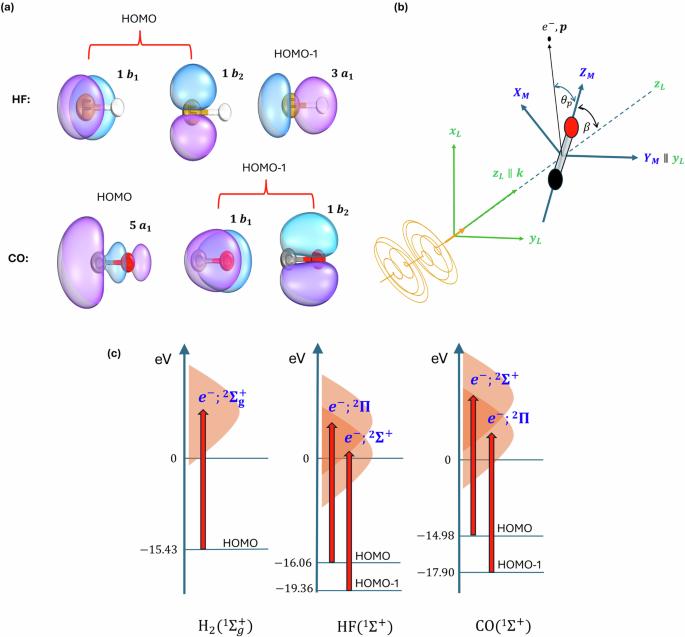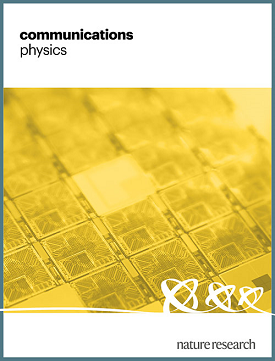Orientation-dependent production of normal Archimedean and dynamical spirals for revealing orbital symmetries in diatomic multi-orbital molecules
IF 5.4
1区 物理与天体物理
Q1 PHYSICS, MULTIDISCIPLINARY
引用次数: 0
Abstract
The discovery and measurements of symmetric normal Archimedean spirals from atomic ionization by a pair of time-delayed broadband oppositely circularly polarized pulses revealed their potential of discerning orbital symmetry in atoms. Transferring this tool to molecules substantially increases experimental and theoretical challenges. Here, we show how Einstein’s photoelectric effect bypasses the congestion of electronic intermediate states and can access the orbital symmetry in heteronuclear, multi-orbital aligned molecules. Thanks to the broad bandwidth, multi-orbital ionization leads to multiplexed molecular-frame photoelectron momentum distributions, hiding thus any molecular orbital information. Only when molecular orientation is used to manipulate the ionization channels that one can identify a robust doorway into the molecular quantum world in which the asymmetry inherent to the highest-occupied molecular orbital can be unambiguously revealed by the asymmetric molecular spirals from single-color pulses. Our results demonstrate the potential of polarization-tailored attopulse sequences for the retrieval of spectroscopic details on molecular orbital symmetries. For pulse bandwidth larger than the energy gap between molecular orbitals, distinguishing contributions of electrons photoionized from different orbitals is a major hurdle. Here, the authors mitigate this issue by rotating light with respect to the molecular axis and show that asymmetric spirals are a new source of information for molecular orbital symmetries.

揭示二原子多轨道分子轨道对称性的正常阿基米德螺旋和动力学螺旋的方向依赖性产生
通过一对延时宽带对向圆极化脉冲发现并测量原子电离产生的对称正阿基米德螺旋,揭示了其辨别原子轨道对称性的潜力。将这一工具转移到分子上,大大增加了实验和理论上的挑战。在这里,我们展示了爱因斯坦光电效应如何绕过电子中间态的拥塞,获取异核多轨道排列分子的轨道对称性。由于带宽较宽,多轨道电离导致分子帧光电子动量分布复用,从而隐藏了任何分子轨道信息。只有当分子取向被用来操纵电离通道时,我们才能找到进入分子量子世界的有力通道,在这个通道中,最高占位分子轨道固有的非对称性可以通过来自单色脉冲的非对称分子螺旋毫不含糊地揭示出来。我们的研究结果表明,偏振定制的附加脉冲序列具有检索分子轨道对称性光谱细节的潜力。对于脉冲带宽大于分子轨道间能隙的情况,区分不同轨道光离子化电子的贡献是一个主要障碍。在此,作者通过光相对于分子轴的旋转来缓解这一问题,并证明不对称螺旋是分子轨道对称性的新信息来源。
本文章由计算机程序翻译,如有差异,请以英文原文为准。
求助全文
约1分钟内获得全文
求助全文
来源期刊

Communications Physics
Physics and Astronomy-General Physics and Astronomy
CiteScore
8.40
自引率
3.60%
发文量
276
审稿时长
13 weeks
期刊介绍:
Communications Physics is an open access journal from Nature Research publishing high-quality research, reviews and commentary in all areas of the physical sciences. Research papers published by the journal represent significant advances bringing new insight to a specialized area of research in physics. We also aim to provide a community forum for issues of importance to all physicists, regardless of sub-discipline.
The scope of the journal covers all areas of experimental, applied, fundamental, and interdisciplinary physical sciences. Primary research published in Communications Physics includes novel experimental results, new techniques or computational methods that may influence the work of others in the sub-discipline. We also consider submissions from adjacent research fields where the central advance of the study is of interest to physicists, for example material sciences, physical chemistry and technologies.
 求助内容:
求助内容: 应助结果提醒方式:
应助结果提醒方式:


